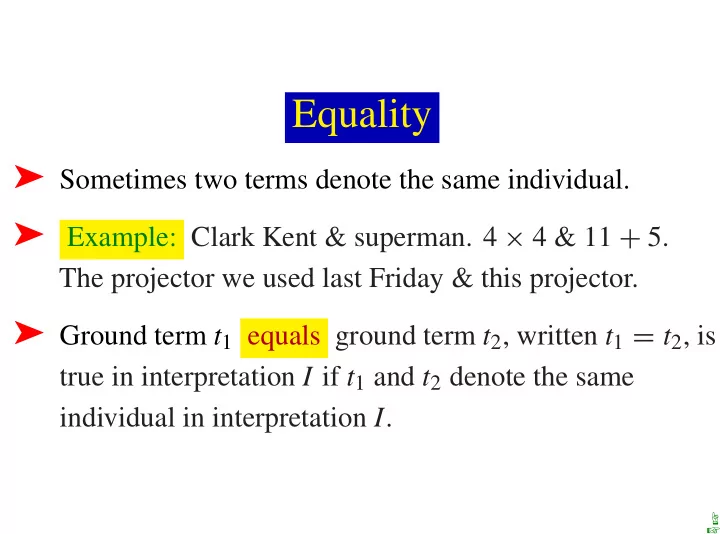

Equality ➤ Sometimes two terms denote the same individual. ➤ Example: Clark Kent & superman. 4 × 4 & 11 + 5. The projector we used last Friday & this projector. ➤ Ground term t 1 equals ground term t 2 , written t 1 = t 2 , is true in interpretation I if t 1 and t 2 denote the same individual in interpretation I . ☞ ☞
Equality doesn’t mean similarity chair 1 chair 2 chair 1 �= chair 2 chair _ on _ right = chair 2 chair _ on _ right is not similar to chair 2, it is chair 2. ☞ ☞ ☞
Allowing Equality Assertions ➤ Without equality assertions, the only thing that is equal to a ground term is itself. This can be captured as though you had the assertion X = X . Explicit equality never needs to be used. ➤ If you allow equality assertions, you need to derive what follows from them. Either: ➣ axiomatize equality like any other predicate ➣ build special-purpose inference machinery for equality ☞ ☞ ☞
Axiomatizing Equality X = X . X = Y ← Y = X . X = Z ← X = Y ∧ Y = Z . For each n -ary function symbol f there is a rule of the form f ( X 1 , . . . , X n ) = f ( Y 1 , . . . , Y n ) ← X 1 = Y 1 ∧ · · · ∧ X n = Y n . For each n -ary predicate symbol p , there is a rule of the form p ( X 1 , . . . , X n ) ← p ( Y 1 , . . . , Y n ) ∧ X 1 = Y 1 ∧ · · · ∧ X n = Y n . ☞ ☞ ☞
Special-Purpose Equality Reasoning paramodulation: if you have t 1 = t 2 , then you can replace any occurrence of t 1 by t 2 . Treat equality as a rewrite rule , substituting equals for equals. You select a canonical representation for each individual and rewrite all other representations into that representation. Example: treat the sequence of digits as the canonical representation of the number. Example: use the student number as the canonical representation for students. ☞ ☞ ☞
Unique Names Assumption The convention that different ground terms denote different individuals is the unique names assumption. for every pair of distinct ground terms t 1 and t 2 , assume t 1 �= t 2 , where “ �= ” means “not equal to.” Example: For each pair of courses, you don’t want to have to state, math 302 �= psyc 303, … Example: Sometimes the unique names assumption is inappropriate, for example 3 + 7 �= 2 × 5 is wrong. ☞ ☞ ☞
Axiomatizing Inequality for the UNA ➤ c �= c ′ for any distinct constants c and c ′ . ➤ f ( X 1 , . . . , X n ) �= g ( Y 1 , . . . , Y m ) for any distinct function symbols f and g . ➤ f ( X 1 , . . . , X n ) �= f ( Y 1 , . . . , Y n ) ← X i �= Y i , for any function symbol f . There are n instances of this schema for every n -ary function symbol f (one for each i such that 1 ≤ i ≤ n ). ➤ f ( X 1 , . . . , X n ) �= c for any function symbol f and constant c . ➤ t �= X for any term t in which X appears (where t is not the term X ). ☞ ☞ ☞
Top-down procedure and the UNA ➤ Inequality isn’t just another predicate. There are infinitely many answers to X �= f ( Y ) . ➤ If you have a subgoal t 1 �= t 2 , for terms t 1 and t 2 there are three cases: ➣ t 1 and t 2 don’t unify. In this case, t 1 �= t 2 succeeds. ➣ t 1 and t 2 are identical including having the same variables in the same positions. Here t 1 �= t 2 fails. ➣ Otherwise, there are instances of t 1 �= t 2 that succeed and instances of t 1 �= t 2 that fail. ☞ ☞ ☞
Implementing the UNA ➤ Recall: in SLD resolution you can select any subgoal in the body of an answer clause to solve next. ➤ Idea: only select inequality when it will either succeed or fail, otherwise select another subgoal. Thus you are delaying inequality goals. ➤ If only inequality subgoals remain, and none fail, the query succeeds. ☞ ☞
Recommend
More recommend